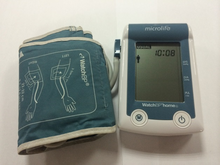AFIB Technology (sometimes referred to as Microlife AFIB Technology) is a feature in sphygmomanometer devices that is designed to detect and monitor the incidence of atrial fibrillation in patients. The technology was designed, patented, and is currently used by the Microlife Corporation. It has been the subject of numerous medical studies and has been validated for in-home and clinical use. It can be found in several Microlife devices, including the WatchBP Home A, BP A200 Plus, WatchBP Office, and WatchBP O3.
Specifications

The Microlife devices that use the AFIB Technology are oscillometric and are equipped with an algorithm that can detect irregular pulse rhythms. The device will flash if atrial fibrillation is detected. Measurements are carried out in triplicate for more accurate readings. Studies have confirmed the relative accuracy of such readings when attempting to identify the existence of atrial fibrillation in patients.
One study indicated that the Microlife blood pressure monitor had a sensitivity for detecting atrial fibrillation of 100%, a specificity of 92%. Several clinical studies have tested the Microlife AFIB Technology against 12-lead electrocardiography (ECG) interpreted by cardiologists. The sensitivity for detection in these studies varied between 95 and 100% with specificity values of 89 to 92%.

One study noted that the WatchBP device was better for detecting atrial fibrillation than single-lead ECGs because of its higher specificity level (90 vs 76%, respectively), which would prevent many unnecessary refers for a 12-lead ECG and therefore safes labor and healthcare costs. In addition, it does not require clinical interpretation.
In virtually every study, researchers have concluded that Microlife's AFIB Technology is suitable for use as an atrial fibrillation detection system for in-home and/or clinical purposes. In 2013, the UK National Institute for Health and Care Excellence recommended the WatchBP Home A device for routine blood pressure measurement and atrial fibrillation screening in primary care. The recommendation is based on the NICE conclusion that use of WatchBP Home A in primary care is associated with estimated overall cost savings per person measured, ranging from £2.98 for those aged between 65 and 74 years to £4.26 for those aged 75 years and over.
Patents
- U.S. patent 7,706,868 Detecting atrial fibrillation, method of and apparatus for filed February 17, 2006; issued April 27, 2010
- U.S. patent 7,680,532 Detecting atrial fibrillation, method of and apparatus for filed February 15, 2006; issued March 16, 2010
- U.S. patent 7,020,514 Method of and apparatus for detecting atrial fibrillation filed November 27, 2002; issued March 28, 2006
- U.S. patent 6,519,490 Method of and apparatus for detecting arrhythmia and fibrillation filed December 20, 1999; issued February 11, 2003
References
- ^ Mahendra, Piriya (21 January 2013). "NICE recommends BP monitor for atrial fibrillation detection". medwireNews. Retrieved 27 May 2015.
- ^ McNamee, David (14 August 2014). "Home blood pressure monitors: how do they stack up?". Medical News Today. Retrieved 27 May 2015.
- ^ Wiesel, J; Arbesfeld, B; Schechter, D (1 October 2014). "Comparison of the Microlife blood pressure monitor with the Omron blood pressure monitor for detecing atrial fibrilation". American Journal of Cardiology. 114 (7): 1046–8. doi:10.1016/j.amjcard.2014.07.016. PMID 25212546.
- ^ Kearley, Karen; Selwood, Mary; Van den Bruel, Ann; Thompson, Matthew; Mant, David; Hobbs, Richard; Fitzmaurice, David; Heneghan, Carl (2 May 2014). "Triage tests for identifying atrial fibrillation in primary care: a diagnostic accuracy study comparing single-lead ECG and modified BP monitors". BMJ Open. 4 (5): e004565. doi:10.1136/bmjopen-2013-004565. PMC 4025411. PMID 24793250.
- ^ Stergiou, GS; Karpettas, N; Protogerou, A; Nasothimiou, EG; Kyriakidis, M (12 February 2009). "Diagnostic accuracy of a home blood pressure monitor to detect atrial fibrillation". Journal of Human Hypertension. 23 (10): 654–658. doi:10.1038/jhh.2009.5. PMID 19279661.
- Willits, Iain; Keltie, Kim; Craig, Joyce; Sims, Andrew (June 2014). "WatchBP Home A for Opportunistically Detecting Atrial Fibrillation During Diagnosis and Monitoring of Hypertension: A NICE Medical Technology Guidance". Applied Health Economics and Health Policy. 12 (3): 255–265. doi:10.1007/s40258-014-0096-7. PMC 4026667. PMID 24664995.
- "Sphygmomanometers for Clinical Use". www.dableducational.org. dabl Educational Trust. Retrieved 27 May 2015.
- "Sphygmomanometers for Self-measurement of Blood Pressure (SBPM)". www.dableducational.org. dabl Educational Trust. Retrieved 27 May 2015.
- ^ Gandolfo, C; Balestrino, M; Bruno, C; Finocchi, C; Reale, N (April 2015). "Validation of a simple method for atrial fibrillation screening in patients with stroke". Neurological Sciences. 36 (9): 1675–8. doi:10.1007/s10072-015-2231-0. PMID 25926072. S2CID 22647913.
- Wiesel, J; Abraham, S; Messineo, FC (1 June 2013). "Screening for asymptomatic atrial fibrillation while monitoring the blood pressure at home: trial of regular versus irregular pulse for prevention of stroke". American Journal of Cardiology. 111 (11): 1598–601. doi:10.1016/j.amjcard.2013.01.331. PMID 23499278.
- Stergiou, George S.; Tzamouranis, Dimitris; Protogerou, Athanasios; Nasothimiou, Efthimia; Kapralos, Christos (October 2008). "Validation of the Microlife WatchBP Office professional device for office blood pressure measurement according to the International protocol". Blood Pressure Monitoring. 13 (5): 299–303. doi:10.1097/MBP.0b013e3283057af6. PMID 18799957. S2CID 9047775.
- Gandolfo, C; Balestrino, M; Bruno, C; Finocchi, C; Reale, N (30 April 2015). "Validation of a simple method for atrial fibrillation screening in patients with stroke". Neurological Sciences. 36 (9): 1675–8. doi:10.1007/s10072-015-2231-0. PMID 25926072. S2CID 22647913.
- Wiesel, Joseph; Arbesfeld, Benjamin; Schechter, David (17 July 2014). "Comparison of the Microlife Blood Pressure Monitor With the Omron Blood Pressure Monitor for Detecting Atrial Fibrillation". American Journal of Cardiology. 114 (7): 1046–8. doi:10.1016/j.amjcard.2014.07.016. PMID 25212546. Retrieved 27 May 2015.